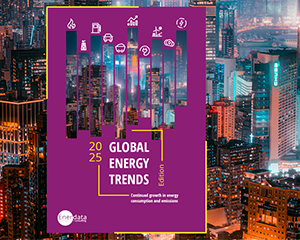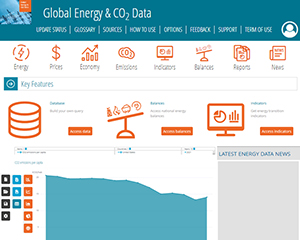Glossary
Average CO2 emission factor
The average CO2 emission factor (carbon factor) is calculated by the ratio between CO2 emissions to primary energy consumption.
CO2 emissions from fuel combustion
CO2 emissions cover only the emissions from fossil fuels combustion (coal, oil and gas) by sector. They are calculated according to the UNFCCC methodology (in line with the 2006 IPCC Guidelines for National Greenhouse Gas Inventories).
CO2 intensity at constant purchasing power parities
CO2 intensity is the ratio of CO2 emissions from fuel combustion over Gross Domestic Product (GDP). It measures the CO2 emitted to generate one unit of GDP. GDP is expressed at constant exchange rate and purchasing power parity to remove the impact of inflation, reflect differences in general price levels and relate energy consumption to the real level of economic activity. Using purchasing power parity rates for GDP instead of exchange rates increases the value of GDP in regions with a low cost of living, and therefore decreases their CO2 intensities. CO2 emissions cover only the emissions for fossil fuels combustion (coal, oil and gas).
Coal and lignite balance of trade
The trade balance is the difference between imports and exports. The balance of a net exporter appears as a negative value (-). The balance of geographic and geopolitical zones is simply the sum of the trade balance of all the countries. Coal and lignite represent all mineral solid fuels. Their calorific values vary very much from hard coal to lignite (national average coefficients are used).
Coal and lignite domestic consumption
Consumption (or domestic supply) is the balance of production, external trade and stock changes. Coal and lignite represent all mineral solid fuels. Their calorific values vary very much from hard coal to lignite (national average coefficients are used).
Coal and lignite production
Coal production corresponds to gross production. Coal and lignite represent all mineral solid fuels. Their calorific values vary very much from hard coal to lignite (national average coefficients are used).
Crude oil balance of trade
The trade balance is the difference between imports and exports. The balance of a net exporter appears as a negative value (-). The balance of geographic and geopolitical zones is simply the sum of the trade balance of all the countries. Crude oil includes all liquid hydrocarbons to be refined: crude oil, liquids from natural gas (Natural Gas Liquid or NGL) and semi-refined products.
Crude oil production
Crude oil production corresponds to gross production. Crude oil includes all liquid hydrocarbons to be refined: crude oil, liquids from natural gas (Natural Gas Liquid or NGL) and semi-refined products.
Electricity balance of trade
The trade balance is the difference between imports and exports. The balance of a net exporter appears as a negative value (-). The balance of geographic and geopolitical zones is simply the sum of the trade balance of all the countries. Electricity corresponds to the electricity produced and transported for commercial purposes, used by ad-hoc devices.
Electricity domestic consumption
Consumption (or domestic supply) is the balance of production and external trade. It is mainly divided between power plants, industry, transport and the residential and tertiary sectors, one part is used or lost in the energy transformation. Electricity corresponds to the electricity produced and transported for commercial purposes, used by ad-hoc devices.
Electricity production
Electricity production corresponds to gross production. It includes the public production (production of private and public electricity utilities) and the autoproducers, by any type of power plants (including cogeneration). Electricity corresponds to the electricity produced and transported for commercial purposes, used by ad-hoc devices.
Energy balance of trade
The trade balance is the difference between imports and exports. The balance of a net exporter appears as a negative value (-). The balance of geographic and geopolitical zones is simply the sum of the trade balance of all the countries. Total energy includes coal, gas, oil, electricity, heat and biomass.
Energy intensity of GDP at constant purchasing power parities
The energy intensity is calculated by dividing the total energy consumption of a country by its Gross Domestic Product (GDP). It measures the total amount of energy necessary to generate one unit of GDP. Total energy consumption includes coal, gas, oil, electricity, heat and biomass. GDP is expressed at constant exchange rate and purchasing power parity to remove the impact of inflation and reflect differences in general price levels and relate energy consumption to the real level of economic activity. Using purchasing power parity rates for GDP instead of exchange rates increases the value of GDP in regions with a low cost of living, and therefore decreases their energy intensities.
LNG balance of trade
The trade balance is the difference between imports and exports. The balance of a net exporter appears as a negative value (-). The balance of geographic and geopolitical zones is simply the sum of the trade balance of all the countries. LNG (liquefied natural gas) is natural gas, mainly made of methane (CH4), that is cooled down at -160°C to become liquid and non-corrosive, and to reduce its volume by around 600 times. LNG can thus be stored in tanks and can be easily transported by ship instead of gas pipelines, increasing the flexibility of global gas trade.
Natural gas balance of trade
The trade balance is the difference between imports and exports. The balance of a net exporter appears as a negative value (-). The balance of geographic and geopolitical zones is simply the sum of the trade balance of all the countries. Natural gas is mainly made of methane (CH4). It is marketed after separation of the liquid fractions. The calorific power of natural gas varies according to its methane concentration. The standard coefficient used by Enerdata is: 0.82 toe/m3, for important countries national coefficients are used.
Natural gas domestic consumption
Consumption (or domestic supply) is the balance of production, external trade and stock changes. Natural gas is mainly made of methane (CH4). It is marketed after separation of the liquid fractions. The calorific power of natural gas varies according to its methane concentration. The standard coefficient used by Enerdata is: 0.82 toe/m3, for important countries national coefficients are used.
Natural gas production
Natural gas production corresponds to the marketed production (i.e. excluding quantities flared or reinjected). Natural gas is mainly made of methane (CH4). It is marketed after separation of the liquid fractions. The calorific power of natural gas varies according to its methane concentration. The standard coefficient used by Enerdata is: 0.82 toe/m3, for important countries national coefficients are used.
Oil products balance of trade
The trade balance is the difference between imports and exports. The balance of a net exporter appears as a negative value (-). The balance of geographic and geopolitical zones is simply the sum of the trade balance of all the countries. Petroleum products are all liquid hydrocarbons, obtained by the refining of crude oil and NGL and by treatment of natural gas; in particular, LPG production (Liquid Petroleum Gas) includes LPG from natural gas separation plants. The alcohol used as motor fuel in Brazil as well as fuels derived from coal in South Africa are not included in oil products.
Oil products domestic consumption
Consumption (or domestic supply) is the balance of production, external trade and stock changes. Marine bunkers are excluded for countries. They are included at the world level. Consumption is mainly divided between power plants, industry, transport and the residential and tertiary sectors, one part is used or lost in the energy transformation. Petroleum products are all liquid hydrocarbons, obtained by the refining of crude oil and NGL and by treatment of natural gas; in particular, LPG production (Liquid Petroleum Gas) includes LPG from natural gas separation plants. The alcohol used as motor fuel in Brazil as well as fuels derived from coal in South Africa are not included in oil products.
Refined oil products production
Petroleum products are all liquid hydrocarbons, obtained by the refining of crude oil and NGL and by treatment of natural gas; in particular, LPG production (Liquid Petroleum Gas) includes LPG from natural gas separation plants. The alcohol used as motor fuel in Brazil as well as fuels derived from coal in South Africa are not included in oil products.
Share of electricity in total final energy consumption
Share of electricity in total final energy consumption.
Share of renewables in electricity production
Ratio between the electricity production from renewable energies (hydro, wind, geothermal and solar) and the total electricity production. Electricity corresponds to the electricity produced and transported for commercial purposes, used by ad-hoc devices.
Share of wind and solar in electricity production
Electricity produced from wind and solar energy divided by the total electricity production.
Total energy consumption
For each energy product, it is the sum of primary production, external trade, marine bunkers (fuel used by boats and aircraft for international transport) and stock variations. For the world, marine bunkers are included. This induces a gap with the sum of regions. Total energy includes coal, gas, oil, electricity, heat and biomass.
Total energy production
The primary production evaluates the quantity of natural energy resources ("primary energy sources") extracted or produced. It includes coal, gas, oil, electricity, heat and biomass production. For natural gas, the quantities flared or reinjected are excluded. Production of hydro, geothermal, nuclear and wind electricity is considered as primary production.
Our 2025 edition of Global Energy Trends presents insights on essential energy data.
We have contextualised these findings against long-term climate targets :
- Which must accelerate their efforts to meet 2050 targets?
- What are the underlying drivers explaining why Europe is struggling to achieve the Paris Agreement objectives?
- Which regions are making substantial contributions to climate mitigation?
Access to the most comprehensive and up-to-date database on energy supply, demand, prices and GHG emissions (186 countries).
- Comprehensive
- Annual energy and GHG data from 1990 onwards
- Up to 2000+ data series and indicators by country per year
- Coverage of all energies in 186 countries
- Reliable
- 30-year experience in energy balances and statistics
- Data and indicators compliant with the best international norms



